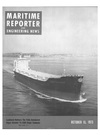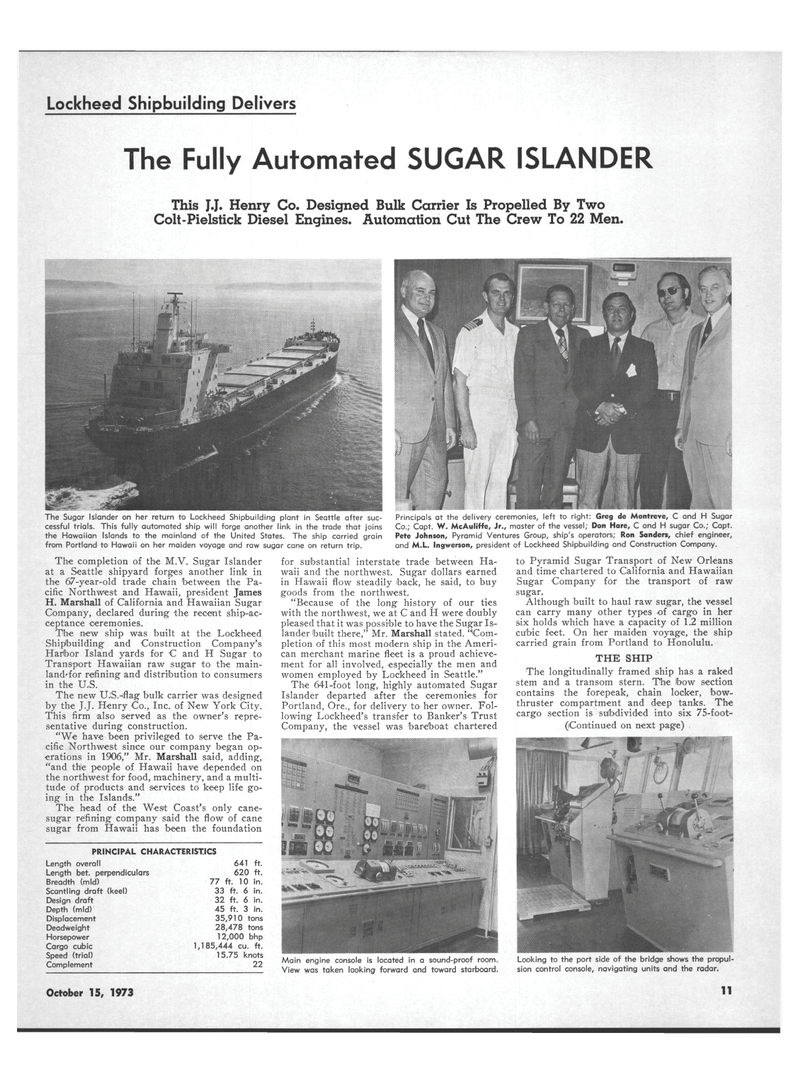
Page 9: of Maritime Reporter Magazine (October 15, 1973)
Read this page in Pdf, Flash or Html5 edition of October 15, 1973 Maritime Reporter Magazine
Lockheed Shipbuilding Delivers
The Fully Automated SUGAR ISLANDER
This IJ. Henry Co. Designed Bulk Carrier Is Propelled By Two
Colt-Pielstick Diesel Engines. Automation Cut The Crew To 22 Men.
October 15, 1973 11
The Sugar Islander on her return to Lockheed Shipbuilding plant in Seattle after suc- cessful trials. This fully automated ship will forge another link in the trade that joins the Hawaiian Islands to the mainland of the United States. The ship carried grain from Portland to Hawaii on her maiden voyage and raw sugar cane on return trip.
Principals at the delivery ceremonies, left to right: Greg de Montreve, C and H Sugar
Co.; Capt. W. McAuliffe, Jr., master of the vessel; Don Hare, C and H sugar Co.; Capt.
Pete Johnson, Pyramid Ventures Group, ship's operators; Ron Sanders, chief engineer, and M.L. Ingwerson, president of Lockheed Shipbuilding and Construction Company.
PRINCIPAL CHARACTERISTICS
Length overall
Length bet. perpendiculars
Breadth (mid)
Scantling draft (keel)
Design draft
Depth (mid)
Displacement
Deadweight
Horsepower
Cargo cubic
Speed (trial)
Complement 641 ft. 620 ft. 77 ft. 10 in. 33 ft. 6 in. 32 ft. 6 in. 45 ft. 3 in. 35,910 tons 28,478 tons 12,000 bhp 1,185,444 cu. ft. 15.75 knots 22 Main engine console is located in a sound-proof room. View was taken looking forward and toward starboard. Looking to the port side of the bridge shows the propul sion control console, navigating units and the radar.
The completion of the M.V. Sugar Islander at a Seattle shipyard forges another link in the 67-year-old trade chain between the Pa- cific Northwest and Hawaii, president James
H. Marshall of California and Hawaiian Sugar
Company, declared during the recent ship-ac- ceptance ceremonies.
The new ship was built at the Lockheed
Shipbuilding and Construction Company's
Harbor Island yards for C and H Sugar to
Transport Hawaiian raw sugar to the main- land'for refining and distribution to consumers in the U,S.
The new UjS.-iflag bulk carrier was designed by the J,J. Henry Co., Inc. of New York City.
This firm also served as the owner's repre- sentative during construction. "We have been privileged to serve the Pa- cific Northwest since our company began op- erations in 1906," Mr. Marshall said, adding, "and the people of Hawaii have depended on the northwest for food, machinery, and a multi- tude of products and services to keep life go- ing in the Islands."
The head of the West Coast's only cane- sugar refining company said the flow of cane sugar from Hawaii has been the foundation for substantial interstate trade between Ha- waii and the northwest. Sugar dollars earned in Haiwaii flow steadily back, he said, to buy goods from the northwest. "Because of the long history of our ties with the northwest, we at C and H were doubly pleased that it was possible to have the Sugar Is- lander built there," Mr. Marshall stated. ^Com- pletion of this most modern ship in the Ameri- can merchant marine fleet is a proud achieve- ment for all involved, especially the men and women employed by Lockheed in Seattle."
The 641-foot long, highly automated Sugar
Islander departed after the ceremonies for
Portland, Ore., for delivery to her owner. Fol- lowing Lockheed's transfer to Banker's Trust
Company, the vessel was bareboat chartered to Pyramid Sugar Transport of New Orleans and time chartered to California and Hawaiian
Sugar Company for the transport of raw sugar.
Although built to haul raw sugar, the vessel can carry many other types of cargo in her six holds which have a capacity of 1.2 million cubic feet. On her maiden voyage, the ship carried grain from Portland to Honolulu.
THE SHIP
The longitudinally framed ship has a raked stem and a transom stern. The bow section contains the forepeak, chain locker, 'bow- thruster compartment and deep tanks. The cargo section is subdivided into six 75-foot- (Continued on next page)

 8
8

 10
10
